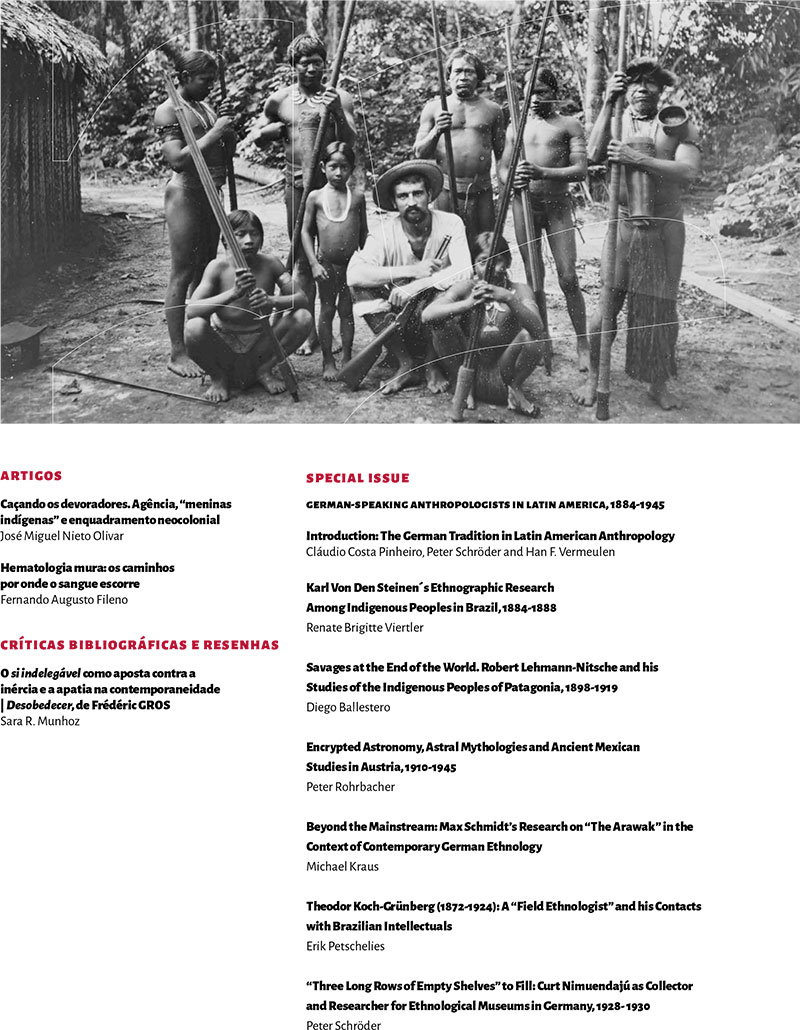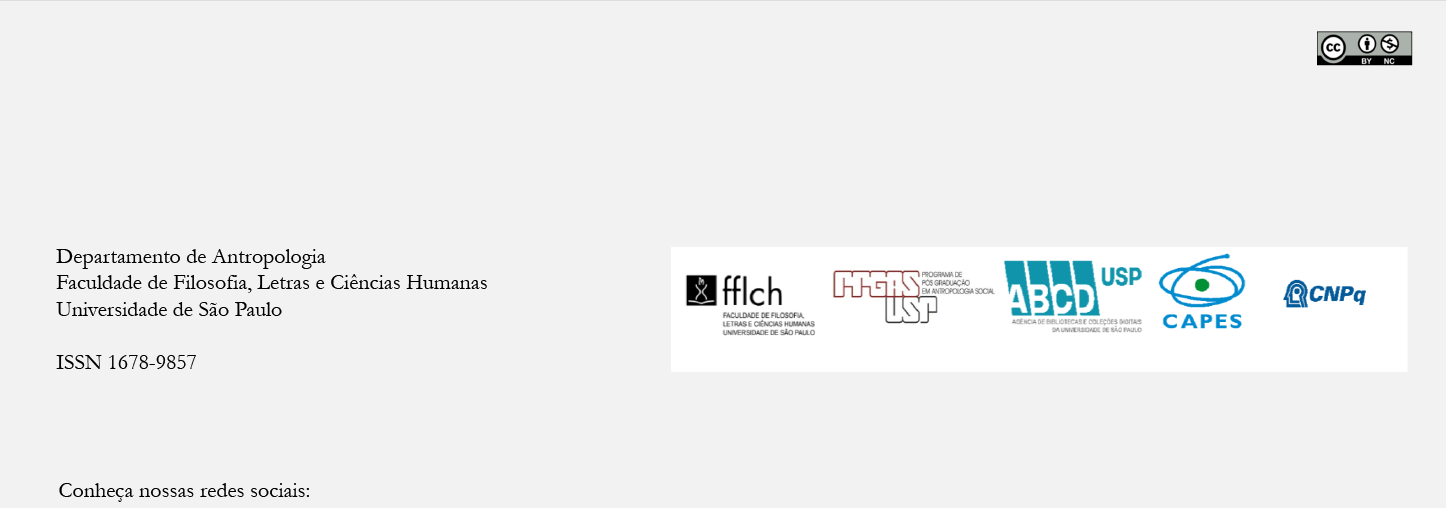Theodor Koch-Grünberg (1872-1924)
A “Field Ethnologist” and his Contacts with Brazilian Intellectuals
DOI:
https://doi.org/10.11606/2179-0892.ra.2019.157039Palavras-chave:
Affonso d’Escragnolle Taunay, Correspondence, João Capistrano de Abreu, Teodoro SampaioResumo
The German ethnologist Theodor Koch-Grünberg (1872-1924) became one of the world’s leading Americanists of his era after having successfully concluded two expeditions to Amazonia. Between 1903 and 1905 he studied indigenous peoples inhabiting the regions of the rivers Rio Negro, Vaupés, and Japurá in northwestern Brazil; between 1911 and 1913 he traveled through northern Brazil and Venezuela investigating local Amerindian communities. He contacted dozens of indigenous peoples, studied their mythology, material culture, and languages. Koch-Grünberg maintained a scientific correspondence with some of the best-informed anthropologists of his time, including Adolf Bastian, Franz Boas, Arnold van Gennep and Paul Rivet. He also exchanged letters with Brazilian colleagues such as João Capistrano de Abreu (1853-1927), Teodoro Sampaio (1855-1937), and Affonso d’Escragnolle Taunay (1876-1958). Through an analysis of primary sources – the correspondence held at the Theodor Koch-Grünberg Archive of the Philipps-Universität Marburg in Germany – this article aims at contributing both to the history of Brazilian social thought and the history of German ethnology by contextualizing these relations within the broader context of social exchanges. Therefore, the history of anthropology should be written in the same way as Koch-Grünberg imagined ethnology: as an international science, based on humanistic principles and grounded on social relations.
Downloads
Referências
Unpublished Documents
VK Mr. Nachlass Theodor Koch-Grünberg. Völkerkündliche Sammlung der Philipps-Uni-versität Marburg [Theodor Koch-Grünberg Archive. Ethnological collection of the Philipps-University Marburg, Germany]
A.1 – A. 37: Scientific correspondence
H.: Photographic collection
Arquivo do Museu Paulista da USP [Archive of the Museu Paulista of the State Uni-versity of São Paulo, Brazil]
Photographic collection
Bibliography
BARTH, Fredrik et al. 2005. One Discipline, Four Ways: British, German, French, and American Anthropology. Chicago/London, University of Chicago Press.
BUNZL, Matti. 1996. “Franz Boas and the Humboldtian Tradition: From Volksgeist and Nataionalcharakter to an Anthropological Concept of Culture” In: STOCKING JR., George W. (ed.). Volksgeist as Method and Ethic: Essays on Boasian Ethnography and the German Anthropological Tradition. Madison, University of Wisconsin Press.
CANDIDO, Antonio. 2006. “A sociologia no Brasil”. Tempo social. Revista de Sociologia da USP, São Paulo, v. 18 (1): 271-301.
CHRISTINO, Beatriz Protti. 2006. A rede de Capistrano de Abreu (1853-1927): uma análise historiográfica do rã-txa hu-ni-ku~i em face da Sulamericanística dos anos 1890-1929, São Paulo, PhD thesis, University of São Paulo.
CHRISTINO, Beatriz Protti. 2007. “Os vaivéns da rede (internacional) de Capistrano de Abreu.” Revista do Instituto de Estudos Brasileiros, São Paulo, v. 45: 37-62.
CLAUßEN, Susanne. 2009. Anschauungssache Religion: Zur musealen Repräsentation religiöser Artefakte. Bielefeld, transcript Verlag.
COSTA, Ivoneide de França. 2007. O Rio São Franciso e a Chapada Diamantina nos desenhos de Theodoro Sampaio. Salvador, master thesis, Federal University of Bahia.
CUNHA, Olívia Maria Gomes da. 2004. “Tempo imperfeito: uma etnografia do arquivo.” Mana, Rio de Janeiro, v. 10 (2): 287-322.
EHRENREICH, Paul. 1887. “Über die Botocudos der brasilianischen Provinzen Espiritu Santo und Minas Geraes.” Zeitschrift für Ethnologie, Berlin, v. 19: 1-46, 49-82.
GONTIJO, Rebeca. 2010. “Capistrano de Abreu, viajante.” Revista Brasileira de História, São Paulo, v. 30, n. 59: 15-36.
INGOLD, Tim. 2011. Being Alive: Essays on Movement, Knowledge and Description. London/New York, Routledge.
KOCH-GRÜNBERG, Theodor. 1900. “Zum Animismus der südamerikanischen Indianer.” Internationales Archiv für Ethnographie, Leiden, supplement, v. XIII: 1-162.
KOCH-GRÜNBERG, Theodor. 1908. “Einige Bemerkungen zu der Forschungsreise des Dr. H. Rice in den Gebieten zwischen Guaviare und Caquetá-Yapurá.” Globus. Illustrierte Zeitschrift für Länder- und Völkerkunde, Braunschweig, v. 93: 302-305.
KOCH-GRÜNBERG, Theodor. 1909. “Zwei Jahre unter den Indianern: Reisen in Nordwest-Brasilien, 1903-1905”. Stuttgart: Strecker & Schröder, v. 1 & 2.
KOCH-GRÜNBERG, Theodor. 1917. “Vom Roraima zum Orinoco. Ergebnisse einer Reise in Nordbrasilien und Venezuela in den Jahren 1911-1913”. Berlim: Dietrich Reimer (Ernst Vohsen), v. I.
KOCH-GRÜNBERG, Theodor. 1920. Indianermärchen aus Südamerika. Jena, Eugen Dietrichs.
KOCH-GRÜNBERG, Theodor. 1923a. “Vom Roraima zum Orinoco. Ergebnisse einer Reise in Nordbrasilien und Venezuela in den Jahren 1911-1913”. Berlim: Dietrich Reimer (Ernst Vohsen), v. III.
KOCH-GRÜNBERG, Theodor. 1923b. “Vom Roraima zum Orinoco. Ergebnisse einer Reise in Nordbrasilien und Venezuela in den Jahren 1911-1913”. Berlim: Dietrich Reimer (Ernst Vohsen), v. V.
KOCH-GRÜNBERG, Theodor. 1924. “Vom Roraima zum Orinoco. Ergebnisse einer Reise in Nordbrasilien und Venezuela in den Jahren 1911-1913”. Berlim: Dietrich Reimer (Ernst Vohsen), v. II.
KOCH-GRÜNBERG, Theodor. 1928. “Vom Roraima zum Orinoco. Ergebnisse einer Reise in Nordbrasilien und Venezuela in den Jahren 1911-1913”. Berlim: Dietrich Reimer (Ernst Vohsen), v. IV.
KOEPPING, Klaus-Peter. 1983. Adolf Bastian and the Psychic Unity of Mankind: The Foundations of Anthropology in Nineteenth Century Germany. St. Lucia, University of Queensland Press. Revised version Münster/Hamburg/London, LIT Verlag, 2000; reprinted 2005.
KRAUS, Michael. 2004a. “Am Anfang war das Scheitern: Theodor Koch-Grünberg und die ‘zweite Meyer’sche Schingú-Expedition.’” In KRAUS, Michael (ed.). KOCH-GRÜNBERG, Theodor. Die Xingu-Expedition (1898-1900). Ein Forschungstagebuch. Köln/Weimar/Wien, Böhlau Verlag, pp. 453-496.
KRAUS, Michael. 2004b. Bildungsbürger im Urwald. Die deutsche ethnologische Amazonienforschung (1884-1929). Marburg, Curupira.
KRAUS, Michael (ed.). 2004. KOCH-GRÜNBERG, Theodor, Die Xingu-Expedition (1898-1900). Ein Forschungstagebuch. Köln/Weimar/Wien, Böhlau Verlag.
KRAUSE, Fritz. 1921. Die Kultur der kalifornischen Indianer in ihrer Bedeutung für die Ethnologie und die nordamerikanische Völkerkunde. Leipzig, Verlag Otto Spamer.
OLIVEIRA JUNIOR, Paulo Cavalcante. 1994. Affonso d’E. Taunay e a Construção da Memória Bandeirante. Rio de Janeiro, PhD thesis, Federal University of Rio de Janeiro.
PARKIN, Robert. 2005. “The French-Speaking Countries.” In BARTH, Fredrik et al. One Discipline, Four Ways: British, German, French, and American Anthropology. Chicago/ London, University of Chicago Press.
PENNY, H. Glenn. 2002. Objects of Culture: Ethnology and Ethnographic Museums in Imperial Germany. Chapel Hill, University of North Carolina Press.
PENNY, H. Glenn and RINKE, Stefan. 2015. “Germans Abroad: Respatializing Historical Narrative.” Geschichte und Gesellschaft, Göttingen, v. 41: 173-196.
STOCKING, George W., Jr. (ed.). 1996. Volksgeist as Method and Ethic: Essays on Boasian Ethnography and the German Anthropological Tradition. Madison, University of Wisconsin Press.
VERMEULEN, Han F. 2015. Before Boas: The Genesis of Ethnography and Ethnology in the German Enlightenment. Lincoln/London, University of Nebraska Press.
VON DEN STEINEN, Karl. 1886. Durch Central-Brasilien. Expedition zur Erforschung des Schingú im Jahre 1884. Leipzig, Verlag F. A. Brockhaus.
VON DEN STEINEN, Karl.1892. Die Bakaïrí-Sprache. Leipzig, K. F. Koehler ́s Antiquarium.
VON DEN STEINEN, Karl.1894. Unter den Naturvölkern Zentral-Brasiliens. Reiseschilderung und Ergebnisse der zweiten Schingú-Expedition, Iillustration Credits
Figure 1: Theodor Koch-Grünberg in Manaus (Brazil), 1903 (VK Mr KG_H_VIII).
Figure 2: João Capistrano de Abreu (Photographic collection of the Archive of the Museu Paulista of the State University of São Paulo).
Figure 3: Teodoro Sampaio (Photographic collection of the Archive of the Museu Paulista of the State University of São Paulo).
Figure 4: Koch-Grünberg’s membership card (VK Mr A. 32, file A).
Figure 5: Affonso d’Escragnolle Taunay (Photographic collection of the Archive of the Museu Paulista of the State University of São Paulo).
Downloads
Publicado
Edição
Seção
Licença
Copyright (c) 2020 Revista de Antropologia

Este trabalho está licenciado sob uma licença Creative Commons Attribution 4.0 International License.
Autores que publicam na Revista de Antropologia concordam com os seguintes termos:
a) Autores mantém os direitos autorais e concedem à revista o direito de primeira publicação, com o trabalho simultaneamente licenciado sob a Licença Creative Commons Attribution que permite o compartilhamento do trabalho com reconhecimento da autoria e publicação inicial nesta revista.
b) Autores têm autorização para assumir contratos adicionais separadamente, para distribuição não-exclusiva da versão do trabalho publicada nesta revista (ex.: publicar em repositório institucional ou como capítulo de livro), com reconhecimento de autoria e publicação inicial nesta revista.
c) Autores têm permissão e são estimulados a publicar e distribuir seu trabalho online (ex.: em repositórios institucionais ou na sua página pessoal) após o processo editorial, já que isso pode gerar alterações produtivas, bem como aumentar o impacto e a citação do trabalho publicado (Veja O Efeito do Acesso Livre).




